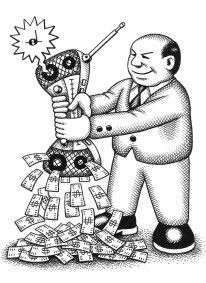Media Trending: Spending Up, Usage Slightly Declining
Labels: 2007, Consumers, Future of Radio, Joint Communications, Media, Media trending, Predictions, Radio, Revenue, Usage, VSS Has media reached a new usage plateau? A new level of consumer saturation? What's a new view of the future for media?
Has media reached a new usage plateau? A new level of consumer saturation? What's a new view of the future for media?
Private equity firm Veronis Suhler Stevenson (VSS) has released a new study forecasting spending in the media industry into 2011. The study found that while communications spending increased in 2006, consumer media usage actually dropped after multiple years of growth.
Total communications spending grew 6.8 percent to $885.2 billion in 2006. VSS predicts that in the first half of 2007, the industry will grow by 6.4 percent, making it among the fastest growing sectors of the U.S. economy.
VSS also predicts that Internet advertising will replace newspapers as the largest ad medium by 2011.
Meanwhile, media usage per person declined last year by 0.5 percent, according to their data, due to changing consumer behavior and the efficiency of digital media. VSS found that digital alternatives for news and entertainment require less time investment than traditional media. VSS predicts consumer media usage to stabilize this year and slightly increase through 2011.
Consumers are also moving away from ad-supported media, such as broadcast TV and newspapers. VSS labels options such as video games and cable TV "consumer-supported platforms," and says their usage is increasing as time with ad-supported media decreases.
"We are in the midst of a major shift in the media landscape that is being fueled by changes in technology, end-user behaviors and the response by brand marketers and communications companies," said James Rutherfurd, EVP and Managing Director for VSS. "We expect these shifts to continue over the next five years, as time and place shifting accelerate while consumers and businesses utilize more digital media alternatives, strengthening the new media pull model at the expense of the traditional media push model."
If we have reached a new plateau of media consumption, it is worthwhile to take a look around the media landscape right now. Who has survived? Which platforms are still thriving? Still hanging on?
More specifically, take a look at radio. Good news...radio still operates with strength. It is simple, reliable, cost-effective and still is used weekly by 94% of the population. Radio has gone through tremendous industry change and competitive challenge from new media options...and radio still survives.
Is radio ready to rev it back up and go after the demographic it has nearly lost (teens) or the demographic it has turned away from (Boomers)?
posted by Unknown @ Saturday, August 18, 2007,
,
![]()
![]()
New Adventures in Media Trend Watching
Labels: Chris Kennedy, Future, Future of Radio, John Parikhal, Joint Communications, Jointblog, Media, Media Trend Watching, Radio, Strategy "Move forward, young man...while you are still young."
"Move forward, young man...while you are still young."
Not sure who said that but I do know a consulting associate from Joint Communications -- Bob Elliot -- who was once asked how he defined growth.
He said, "Well, if you are not growing, you're dead."
Perhaps a little blunt but there is truth in those words, both personally and professionally.
We all seek growth in various forms through our relationships, our businesses and careers, our learning, our finances...the list goes on and on.
As Peter Drucker has said (loosely paraphrased), an important key in growing successful long-term management is for executives, directors and managers to periodically return to day-to-day operations and get away from the "boardroom". It allows for managers to understand what has changed and what needs to happen for future growth.
In the rush-rush of decision making and strategic guidance throughout fiscal years following the pressures of meeting budget and performance expectations, managers can easily shift away from the realities out on the floor before they realize it.
Consultants are no different.
We fly in, work our magic, stir up the team toward growth and fly back home, following up to help make sure decisions stick into on-going action.
This ability to lend an outside perspective to operations allows consultants to see competitive challenges partner clients may not be able to see for themselves. It is a major strength for the consulting role, one that the rapidly-evolving media industry still needs for both the mature sectors of "traditional" media like radio, TV, the music industry, magazines and newspapers...as well as for "new" media, such as cable, modern telephony, wireless, satellite, and all-things related to the Internet.
But, over time, this outside role has its limitation, for the consultant remains on the "outside" of everyday operations. With so many constant and fast changes happening in media, getting back periodically into the daily functions of media business keeps the consultant up-to-date with industry realities.
Which is why I have made a new step forward.
For the last 15 years, I have worked and partnered with John Parikhal at Joint Communications consulting our international roster of media clients. An amazing thrill for me, allowing for constant learning, unique situational decision making, and cross-pollination experience throughout the media industry's up-phases, downturns, IPOs, mergers & acquistions and new tech advancements.
For the past couple months, I've been getting operational again, serving as Program Director for Montreal's Q92fm -- a heritage mainstream AC radio station and one of Corus Radio's many great stations across Canada. It's a new adventure for me, allowing me to pursue growth on a whole new level for a long-time client.
Of personal and professional importance, it also allows me to "get operational again" doing what I love to do: programming radio, coaching talent, building cooperation and communication between station departments, getting deeply involved with the community, building new station events and promotions, managing brand building efforts, and, ultimately, entertaining our audience in the best way possible while also serving as an effective advertising media choice among our station clients.
It's media trend watching on the street level. And I'm having a blast.
What better way to understand the "future of radio" than following Peter Drucker's advice and getting operational again?
I'm proud of what has been accomplished with Joint Communications and our clients. The Jointblog is the #1 destination online for people interested in media trend watching (according to all the search engine results and traffic meters)...these changes will offer a new new level of perspective for future Jointblog posts.
We encourage you to keep sharing your thoughts.
And keep Jointblogging!
We will.
I'm off now for our street festival concert event...literally getting back to street level...
posted by Unknown @ Sunday, July 15, 2007,
,
![]()
![]()
Radio For Sale: The End of Radio Station Super-Sizing
Labels: Acquisitions, Big Media, Consolidation, For Sale, Future of Radio, Media Trend Watching, merger, NAB, Post-Telecom, Privatization, Radio, Radio Stations, Sell, Super-sizing Radio's been hot on the selling blocks lately, with more than two thousand station transactions in 2006 in the U.S. The last time that many stations were sold off was back in 1997.
Radio's been hot on the selling blocks lately, with more than two thousand station transactions in 2006 in the U.S. The last time that many stations were sold off was back in 1997.
The difference?
Then: consolidation merger mania. Now: The post-consolidation end of super-sizing.
Clear Channel leads the "For Sale" movement spinning off lesser market properties while trying to go private. Spanish-broadcasters Univision did go private last June for almost $13 billion. Infinity shed about 35 stations in the past 6 months. Bonneville station swapped with Entercom. And, most recently, Citadel completed its 18-month financial journey purchasing ABC Radio. The last time radio saw this amount of selling action was right after the Telecom Bill of 1996, which changed all the owership limit rules, spurred fast merger and acquisition consolidation and created super-sized radio groups.
The last time radio saw this amount of selling action was right after the Telecom Bill of 1996, which changed all the owership limit rules, spurred fast merger and acquisition consolidation and created super-sized radio groups.
Back then, market values for stations soared as groups raced to get "big" as fast as possible...all in the name of increasing radio's competitive position for ad dollars against other media (or so we were told), damn the consequences.
Ten years later, stations are selling again...but the motivation is different this time around.
"Less is more" might really mean "cluster/group right-sizing".
Instead of station sales creating mega radio groups, radio is scaling back by selling off to smaller groups...or even to brand new small groups. This brings more competition back into radio and creates more-manageable operations, especially in the unrated, small-sized, and mid-sized markets.
Radio needs this retro trend of ownership diversfication, which hopefully can attract fresh creativity and innovative content ideas that work.
Meanwhile, station groups in Canada are being sold off, too...with Astral making a play for Standard and CHUM going to BellGlobal...but there's a difference between radio in Canada and the U.S. Now that we've entered the post-consolidation phase, what did the last ten years bring to radio? There are a small few who made a ton of money, some who made a little and then there's the overwhelming majority -- people who lost gigs and careers (and money) as well as radio listeners who gave up, moving on to different (better) media choices (or, at least away from commercial radio and over to either NPR or new media forms of radio).
Now that we've entered the post-consolidation phase, what did the last ten years bring to radio? There are a small few who made a ton of money, some who made a little and then there's the overwhelming majority -- people who lost gigs and careers (and money) as well as radio listeners who gave up, moving on to different (better) media choices (or, at least away from commercial radio and over to either NPR or new media forms of radio).
Radio remains important and profitable. This new active buy/sell phase is good for radio, leading to smaller major radio groups (as opposed to massive, complex-to-manage divisions).
With all these recent station sell-offs, what bodes for radio's future? Will it improve quality? Minimally, the gap between executive management and the content will shrink somewhat (that's good). Will radio reinvest in creativity and real (not just financial) innovation? Going private and having radio less beholden to Wall Street is also a good thing. But what about that elusive increase in radio's share of total advertising dollars?
And what about radio's issue fighting against the proposed XM/Sirius merger when radio is trying to get its own house in order?
The chart below shows the amount of station selling activity last year:
BIAfn reports:For the first time since 1997 radio station transactions reached levels above 2,000 in 2006, according to the first edition of BIA Financial Network’s quarterly Investing In Radio® Market Report. The breakdown of 1,544 station sales in radio markets (as defined by Arbitron) and 562 unrated areas last year (compared with 1,613 and 637, respectively, in 1997) [led by the proposed privatization of Clear Channel Communications]...demonstrate an interest in the purchase of small market stations as long term investments.
 Is radio making a U-Turn? Is old school sanity returning to radio? Was the consolidation run-up just another merger mania cash grab? Did radio watch "Super Size Me" and decide it needed to reduce to "get healthy"?
Is radio making a U-Turn? Is old school sanity returning to radio? Was the consolidation run-up just another merger mania cash grab? Did radio watch "Super Size Me" and decide it needed to reduce to "get healthy"?
Will former radio leaders run out of the industry due to consolidation find new opportunities to return and reinvest? Will Wall Street continue to downgrade radio? Is the unretirement of Dan Mason a sign of things to come for the industry?
So what is the future of radio? There will be lots to discuss at next week's NAB show in Las Vegas April 14-19.
posted by Unknown @ Sunday, April 08, 2007,
,
![]()
![]()















